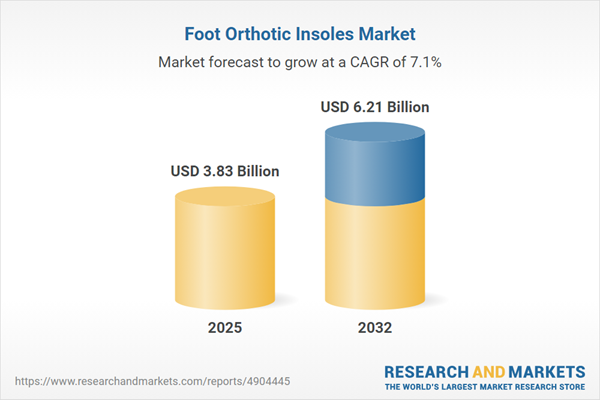Speak directly to the analyst to clarify any post sales queries you may have.
The foot orthotic insoles market is experiencing rapid evolution, shaped by advances in medical technology, digital health integration, and shifting consumer preferences. Across healthcare sectors and direct-to-consumer channels, decision-makers face a dynamic landscape of innovation, regulatory change, and competitive differentiation.
Market Snapshot: Foot Orthotic Insoles Market Overview
The Foot Orthotic Insoles Market grew from USD 3.58 billion in 2024 to USD 3.83 billion in 2025. It is expected to continue growing at a CAGR of 7.09%, reaching USD 6.21 billion by 2032. This growth is propelled by increased demand for corrective devices that support both clinical outcomes and consumer comfort. Factors influencing this trajectory include rising incidence of lifestyle-related foot disorders, wider adoption of digital fitting technologies, and regulatory validation supporting clinical pathways.
Scope & Segmentation
This comprehensive report analyzes a wide range of segments and regions to provide strategic insight across the global foot orthotic insole landscape.
- Product Types: Customized, Prefabricated
- Material Types: Composite carbon fiber, EVA foam, Gel, Leather, Thermoplastic
- User Types: Adults, Pediatric
- Functionalities: Corrective, Cushioning, Support
- Applications: Medical (arch support, diabetic, flat feet, heel pain, plantar fasciitis), Personal & comfort, Sports & athletics
- Distribution Channels: Orthopedic clinics & hospitals, Retail stores, Brand websites, eCommerce platforms
- Regions Covered: Americas, Europe, Middle East & Africa, Asia-Pacific with further breakdowns by major national markets
- Key Companies: Aetrex Inc., Americule Inc., Bauerfeind AG, Bayer AG, BIRKENSTOCK DIGITAL GMBH, Broner Glove & Safety Company, Comfortfit Orthotic Labs Inc., CURREX LLC, DARCO Medical India Pvt. Ltd., Dongwan Mingos Limited, Engel-Netze GmbH & Co. Kg, Foot Levelers Inc., Formthotics by Foot Science International, Hanger Prosthetics and Orthotics Inc., HappyStep, Mandalay Co. Ltd, OrthoLite, Ottobock Holding GmbH, Powerstep, Sorbothane Inc., Implus Footcare LLC, Superfeet Worldwide Inc., Vionic Group LLC
- Technology Coverage: Digital foot scanning, 3D printing, sensor-embedded smart insoles, additive manufacturing, and digital health integration
Key Takeaways
- The primary keyword, "foot orthotic insoles market," addresses both medical and wellness categories, reflecting increasing demand for solutions that bridge clinical efficacy and daily comfort.
- Emerging digital technologies, such as remote patient monitoring and personalized fitting platforms, drive accelerated adoption of customized products alongside traditional offerings.
- Partnerships between sports brands and medical device manufacturers fuel innovation, creating hybrid insoles that serve orthopedic and athletic needs.
- Consumer expectations are reshaping product design, with a strong shift toward modular insole platforms and adaptive materials that cater to diverse user segments.
- Regional nuances play a critical role, particularly where regulatory frameworks, reimbursement models, and urbanization influence product features and distribution strategies.
- Material innovation, with emphasis on sustainability and high-performance composites, is emerging as a key differentiator for both incumbent leaders and new market entrants.
Tariff Impact on the Foot Orthotic Insoles Market
The 2025 introduction of new U.S. tariffs has disrupted the foot orthotic insole supply chain, prompting manufacturers to reconsider raw material sourcing and regional production strategies. Brands are shifting to dual sourcing, nearshoring production, and optimizing product portfolios to reduce tariff exposure and logistics complexity. Compliance expertise and collaboration with trade bodies are now central to navigating new regulatory landscapes and maintaining innovation momentum.
Methodology & Data Sources
This analysis combines extensive secondary research with primary stakeholder interviews. The study consulted peer-reviewed journals, regulatory filings, trade data, and white papers for foundational insights. In-depth interviews with orthopedic specialists, supply chain executives, and retail channel managers validated key trends and provided unique qualitative context. Findings were further triangulated with industry announcements and regional audits.
Why This Report Matters
- Enables senior leaders to benchmark strategy against technology trends, regulatory priorities, and evolving consumer expectations across diverse regional markets.
- Offers actionable intelligence for R&D, supply chain planning, and partnership decisions, supporting resilience and competitive positioning.
- Supports identification of high-impact opportunities in digital health, product innovation, and emerging distribution models.
Conclusion
The market for foot orthotic insoles is transforming rapidly, driven by innovation and changing patient needs. Strategic agility—supported by insights into segmentation, technology integration, and the tariff environment—will be essential for maintaining growth and operational excellence. Stakeholders can leverage this intelligence to adapt, lead, and deliver value in a competitive ecosystem.
Additional Product Information:
- Purchase of this report includes 1 year online access with quarterly updates.
- This report can be updated on request. Please contact our Customer Experience team using the Ask a Question widget on our website.
Table of Contents
3. Executive Summary
4. Market Overview
7. Cumulative Impact of Artificial Intelligence 2025
Companies Mentioned
The companies profiled in this Foot Orthotic Insoles market report include:- Aetrex Inc.
- Americule, Inc.
- Bauerfeind AG
- Bayer AG
- BIRKENSTOCK DIGITAL GMBH
- Broner Glove & Safety Company
- Comfortfit Orthotic Labs Inc.
- CURREX LLC
- DARCO Medical India Pvt. Ltd.
- Dongwan Mingos Limited
- Engel-Netze GmbH & Co. Kg
- Foot Levelers, Inc.
- Formthotics by Foot Science International
- Hanger Prosthetics and Orthotics Inc.
- HappyStep
- Mandalay Co. Ltd
- OrthoLite
- Ottobock Holding GmbH
- Powerstep
- Sorbothane, Inc.
- Implus Footcare, LLC
- Superfeet Worldwide Inc.
- Vionic Group LLC
Table Information
| Report Attribute | Details |
|---|---|
| No. of Pages | 192 |
| Published | November 2025 |
| Forecast Period | 2025 - 2032 |
| Estimated Market Value ( USD | $ 3.83 Billion |
| Forecasted Market Value ( USD | $ 6.21 Billion |
| Compound Annual Growth Rate | 7.0% |
| Regions Covered | Global |
| No. of Companies Mentioned | 24 |









